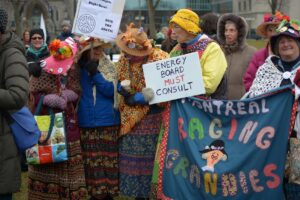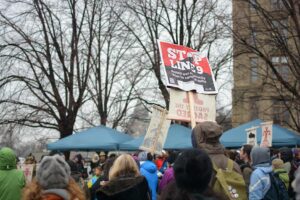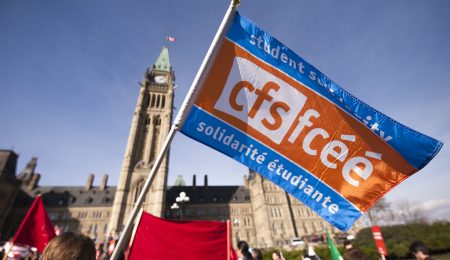Protest follows hearing centered on the right of Indigenous peoples to be consulted on energy projects
On Wednesday, Nov. 30, members of the Ottawa community joined the Inuit peoples of Clyde River and the Chippewas First Nation at the Supreme Court of Canada to rally for Indigenous peoples’ rights, namely for the right to be consulted on energy projects which affect them.
The day began at 6:30 a.m. with an open sunrise ceremony on Victoria Island. Two rallies were held at 8 a.m. and 12 p.m. at the Supreme Court, and a closing ceremony at 4 p.m.
Some of the events that took place during the day included outdoor chants, musical performances during a sundance ceremony, and members of the Indigenous community protesting inside of the Supreme Court building itself.
The rally was held in conjunction with a Nov. 29 hearing at the Supreme Court between the Clyde River Inuit and the Crown over a decision made by the National Energy Board (NEB) that will allow companies to conduct seismic testing in Baffin Bay and Davis Strait near Clyde River, Nunavut for five years.

According to the Clyde River Inuit community, who originally filed this case in 2014, this testing would affect local marine wildlife, as the testing itself involves loud sound explosions which carry through the ocean to search for oil.
Community members of the Chippewas of the Thames First Nations (COTTFN) also attended the rally, due to the Canadian government’s lack of consultation with the community over Enbridge’s Line 9 pipeline reversal project, which aims to send diluted oil sands from Western Canada to Quebec and southern Ontario.
According to Rochelle Smith, a community member of the COTTFN, the case was “around the duty to consult, which is a constitutional duty.”
“It’s the obligation of the Crown to consult and accommodate when it has the potential to impact Aboriginal treaty rights,” said Smith.
Smith explained that Line 9, which is approximately 40 years old, runs through COTTFN’s traditional treaty territories and “has the potential to burst.” Smith also said that the pipeline runs under the community’s watershed, with water being sacred to the community.
“(Water) is a part of our lifestream. It feeds us, it feeds the animals, it grows the plants and the food we eat,” said Smith.
Smith also noted that buses of Indigenous peoples from other communities across Ontario, including Toronto, Hamilton, Guelph, Kitchener-Waterloo, London, and Sarnia, were also in attendance at the rally to stand in solidarity with the Clyde River Inuit.
“It was just great to see all these people gather when we know water is so important to us … Line 9 runs through our community which is detrimental to our lifestyle,” said Smith.
“It’s not only our rights—we look at it as it’s the rights of all humans,” said Smith, noting the student presence at the rally.
According to the Facebook event page, over 2,000 people had indicated their interest in attending the rally, many of whom were students from the University of Ottawa.
“I’d like to see more treaty awareness,” said Smith on possible follow-up action to the rally, referring specifically to the U of O and how the campus is built on unceded Algonquin territory.
In terms of the court hearing, Smith hopes the Crown will honour and uphold Indigenous treaty rights by revoking the decision for the NEB to conduct seismic testing, as well as to consult Indigenous groups in decisions that affects them.
However, the Supreme Court will not reach a decision on this case for several months.
The Facebook event page for the Nov. 30 rally notes that “a win (for the Clyde River Inuit) at the court could be a watershed moment for the future of Indigenous rights and environmental justice.”






